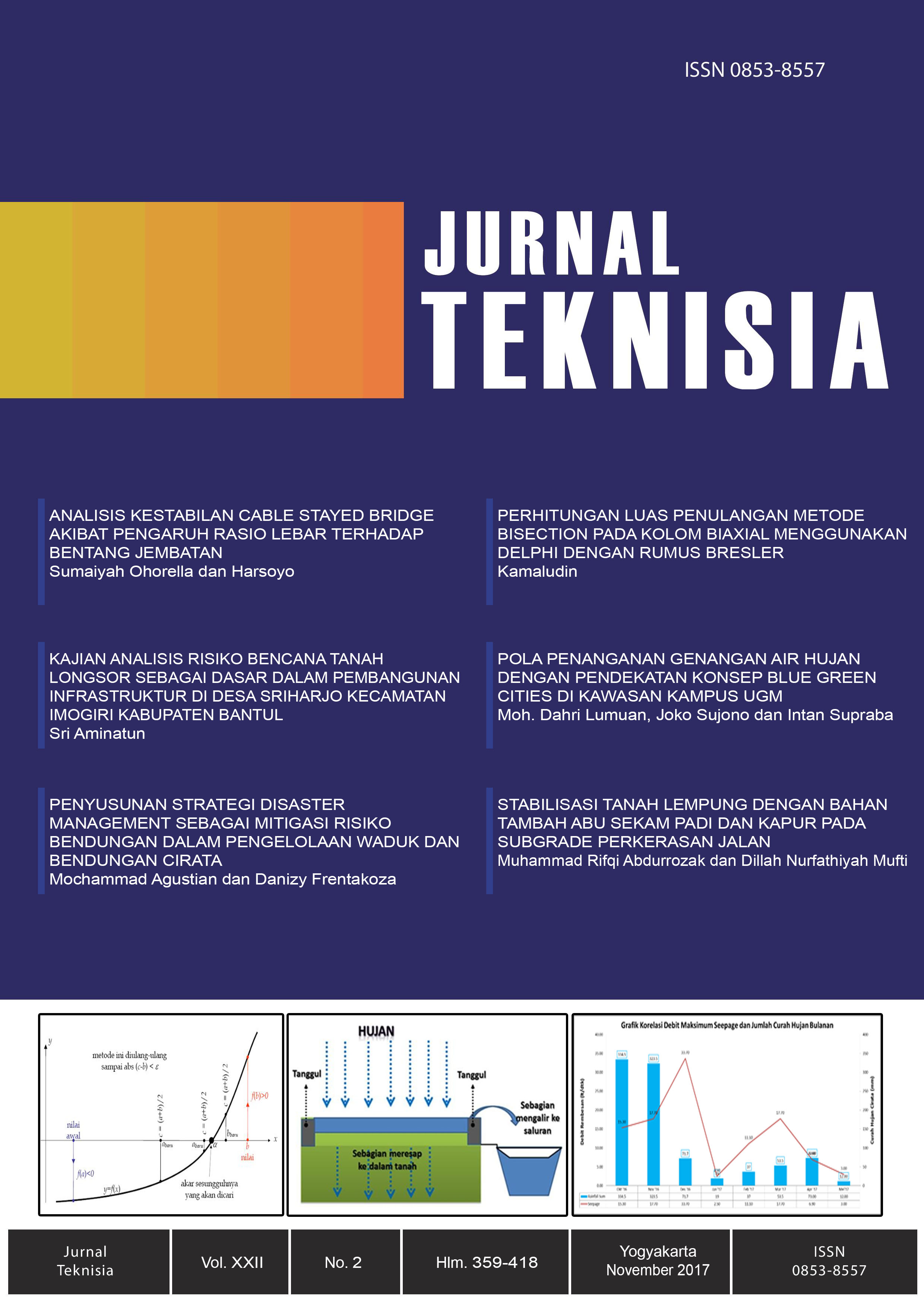Main Article Content
Abstract
Clay is a soft soil type that has fine grained soil characteristics and clay soil is very easy to inflate and shrink (expansive) by changes in water content. This shrinkage factor can cause the pavement layer above to be cracked and wavy. Because the nature makes clay soil as a less stable soil. This study aims to determine the influence of California Bearing Ratio (CBR) with the addition of rice husk ash and lime to soil improvement. Clay is from Kebonharjo village, Samigaluh sub-district, Kulon Progo district. This research used CBR testing method in laboratory using 28 samples. Sample samples conducted CBR testing without immersion and immersion CBR. The sample consisted of native soil with stabilized soil with additional 3%, 5% and 7% rice husk ash and 4% lime to be variable. The result of this research can be concluded that the CBR of original unsoaked soil shows the value of 9.46% and the original soaked soil is 1.16%. Addition of 3% rice husk and Lime 4% gives a significant increase of CBR up to 212% from original soil conditions. The curing process is proven to provide an increase in the CBR value, and at curing for 7 days shows that CBR value will have a constant value. The addition of rice husk ash up to 7% proved to increase the CBR value compared to the value of CBR of original soil. From swelling test shows the higher percentage of rice husk ash material gives the smaller swelling potential from the original soil by 4.8% to 0.032% on addition of rice husk ash (7%) and lime (4%).
Keywords
Article Details
Under the following term:
-
Attribution — You must give appropriate credit, provide a link to the license, and indicate if changes were made. You may do so in any reasonable manner, but not in any way that suggests the licensor endorses you or your use.
-
ShareAlike — If you remix, transform, or build upon the material, you must distribute your contributions under the same license as the original.
- No additional restrictions — You may not apply legal terms or technological measures that legally restrict others from doing anything the license permits.
References
- Abdurrozak, M.R., & Azanna, D.O., Pengaruh Penambahan Abu Sekam Padi terhadap Kapasitas Dukung Pondasi Dangkal pada Tanah Gambut, Jurnal Teknisia, Volume XXII No.1, UII, Yogyakarta.
- Bowles, J dan Hainim, JK, 1986. Sifat-Sifat Fisis dan Geoteknis Tanah (Mekanika Tanah). Edisi Kedua. Erlangga. Jakarta.
- Budi, dkk., 2002, Pengaruh Pencampuran Abu Sekam Padi untuk Stabilisasi Tanah Ekspansif, Dimensi Teknik Sipil ISSN 1410-9530, Universitas Kristen Petra, Surabaya.
- Craig, R.F. 1991. Mekanika Tanah. PT. Erlangga. Jakarta.
- Hajar., 2016, Stabilisasi Tanah Lempung dengan Menggunakan Abu Vulkanik dan Kapur, Tugas Akhir, (Tidak Diterbitkan), Universitas Gadjah Mada, Yogyakarta.
- Ingles, O.G. dan Metcalf, J.B., 1992, “Soil Stabilitzation Principles and Practiceâ€, Butterworths Pty. Limited, Melbourne.
- Ingless, O.G. dan Metcalf, J.B., 1992, “Soil Stabilitzation Principles and Practiceâ€,Butterworths Pty. Limited, Melbourne.
- Lestari., 2008, Stabilisasi Tanah Lempung dengan Menggunakan Fly Ash berdasarkan Pengujian CBR (California Bearing Ratio) dan Kuat Tekan Bebas, Tugas Akhir, (Tidak Diterbitkan), Universitas Gadjah Mada, Yogyakarta.
- Ninik, A. dan Ardiyanto, CN., 2007, Pengaruh Kapur dan Abu Sekam Pada pada Nilai CBR Labpatorium Tanah Tras dari Dusun Seropna untuk Stabilitas Subgrade Timbunan, Majalah Ilmiah UKRIM Edisi I/th XII/2007, Yogyakarta.
- Sukirman, S, 1995, Perkerasan Lentur Jalan Raya, Nova, Bandung.
- Tjokrodimuljo,1992., Teknologi Beton, Gramedia, Yogyakarta.
- Widhiarto, H., Andriawan, A.H., & Matulessy, A., 2017., Stabilisasi Tanah Lempung Ekspansif dengan Menggunakan Campuran Abu-Sekam dan Kapur, Jurnal Pengabdian LPPM Untag, Surabaya.
References
Abdurrozak, M.R., & Azanna, D.O., Pengaruh Penambahan Abu Sekam Padi terhadap Kapasitas Dukung Pondasi Dangkal pada Tanah Gambut, Jurnal Teknisia, Volume XXII No.1, UII, Yogyakarta.
Bowles, J dan Hainim, JK, 1986. Sifat-Sifat Fisis dan Geoteknis Tanah (Mekanika Tanah). Edisi Kedua. Erlangga. Jakarta.
Budi, dkk., 2002, Pengaruh Pencampuran Abu Sekam Padi untuk Stabilisasi Tanah Ekspansif, Dimensi Teknik Sipil ISSN 1410-9530, Universitas Kristen Petra, Surabaya.
Craig, R.F. 1991. Mekanika Tanah. PT. Erlangga. Jakarta.
Hajar., 2016, Stabilisasi Tanah Lempung dengan Menggunakan Abu Vulkanik dan Kapur, Tugas Akhir, (Tidak Diterbitkan), Universitas Gadjah Mada, Yogyakarta.
Ingles, O.G. dan Metcalf, J.B., 1992, “Soil Stabilitzation Principles and Practiceâ€, Butterworths Pty. Limited, Melbourne.
Ingless, O.G. dan Metcalf, J.B., 1992, “Soil Stabilitzation Principles and Practiceâ€,Butterworths Pty. Limited, Melbourne.
Lestari., 2008, Stabilisasi Tanah Lempung dengan Menggunakan Fly Ash berdasarkan Pengujian CBR (California Bearing Ratio) dan Kuat Tekan Bebas, Tugas Akhir, (Tidak Diterbitkan), Universitas Gadjah Mada, Yogyakarta.
Ninik, A. dan Ardiyanto, CN., 2007, Pengaruh Kapur dan Abu Sekam Pada pada Nilai CBR Labpatorium Tanah Tras dari Dusun Seropna untuk Stabilitas Subgrade Timbunan, Majalah Ilmiah UKRIM Edisi I/th XII/2007, Yogyakarta.
Sukirman, S, 1995, Perkerasan Lentur Jalan Raya, Nova, Bandung.
Tjokrodimuljo,1992., Teknologi Beton, Gramedia, Yogyakarta.
Widhiarto, H., Andriawan, A.H., & Matulessy, A., 2017., Stabilisasi Tanah Lempung Ekspansif dengan Menggunakan Campuran Abu-Sekam dan Kapur, Jurnal Pengabdian LPPM Untag, Surabaya.
